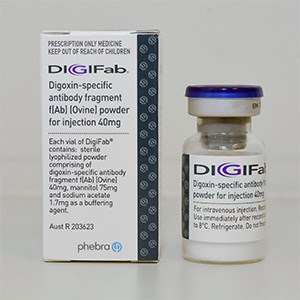Presentation
40mg vial
Keep Refrigerated
Role
To treat severe digoxin or cardiac glycoside poisoning, such as oleander, foxglove and cane toad poisoning associated with:
- Cardiac arrest
- Ventricular arrhythmias or increased automaticity
- Bradyarrhythmia resulting in hypotension

Consultation with a clinical toxicologist is recommended through the local toxicology service or Poisons Information Centre 13 11 26 prior to administration of DigiFab.
Dose
Cardiac arrest due to digoxin or cardiac glycoside toxicity
- Give 5 vials (200mg) IV as a bolus.
Acute digoxin or cardiac glycoside toxicity with compromise
- Give 2 vials (80mg) IV over 30 min. Repeated as necessary on advice of a clinical toxicologist.
Chronic digoxin accumulation with compromise
- Give 1 vial (40mg) diluted in 100mL saline over 30 min.
Cardiac glycoside toxicity from plant/toad related ingestion
- Higher doses may be required, all cases should be discussed with a clinical toxicologist.
Stocking recommendations
| Tertiary centre | Regional centre | Rural centre | Remote centre |
|---|---|---|---|
| 5 vials | 2-5 vials | 0-2 vials | 0 vials |
Rationale
Severe acute cardiac glycoside toxicity requiring DigiFab is rare. The current stocking recommendations reflect a pragmatic approach to antidote availability. Chronic digoxin accumulation is more common. Australian research1 has shown that administration of DigiFab is ineffective in most of these cases. We recommend discussing all cases with a clinical toxicologist prior to administration of DigiFab.
References
- Chan, B.S., et al., Efficacy and effectiveness of anti-digoxin antibodies in chronic digoxin poisonings from the DORA study (ATOM-1). Clin Toxicol (Phila), 2016. 54(6): p. 488-94
Disclaimer
Fact sheet developed by Queensland Poisons Information Centre.
This fact sheet is about the use of these antidotes in Australia, and may not apply to other countries. Children’s Health Queensland Hospital and Health Service cannot be held responsible for the accuracy of information, omissions of information, or any actions that may be taken as a consequence of reading this fact sheet.